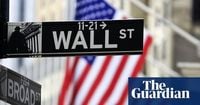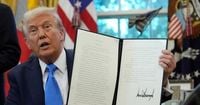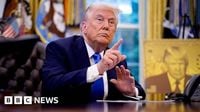On September 19, 2025, President Donald Trump sent shockwaves through the technology and education sectors by signing a proclamation that dramatically increased the application fee for H-1B worker visas. Effective from September 21, 2025, companies wishing to hire skilled foreign workers on H-1B visas must now pay a staggering $100,000 per application—a fiftyfold increase from the previous range of $2,000 to $5,000, according to Al Jazeera and the BBC.
The abrupt announcement ignited immediate panic and confusion across the United States and abroad, especially among Indian professionals, who make up the lion’s share of H-1B recipients. Silicon Valley firms scrambled to advise their staff, with some urging employees not to travel outside the country, while immigration lawyers worked overtime to interpret the new rules. Overseas workers, suddenly uncertain about their futures, rushed to book flights and seek legal counsel.
By Saturday, the White House attempted to calm the storm, clarifying that the $100,000 fee applies only to new H-1B applicants and is a one-time charge. Existing visa holders and those who submitted applications before September 21 are unaffected by the hike. Still, the move left a trail of uncertainty and anxiety in its wake, with many questioning the long-term implications for both the U.S. and the global workforce.
The H-1B program, launched in 1990, has long been a source of both opportunity and controversy. It allows U.S. companies to bring in foreign workers with specialized skills—often in technology, healthcare, and academia—for up to six years. Critics have argued that the visa is sometimes exploited by recruitment firms to hire workers at wages lower than those paid to American employees, thereby undercutting the domestic workforce. Supporters, however, insist it is a vital pipeline for global talent, fueling innovation and keeping the U.S. competitive in critical sectors.
"If you’re going to train somebody, you’re going to train one of the recent graduates from one of the great universities across our land. Train Americans. Stop bringing in people to take our jobs," Commerce Secretary Howard Lutnick said on Friday, echoing concerns about job displacement for U.S. workers.
But the numbers tell a more nuanced story. In 2024, Indian nationals received 71% of approved H-1B visas, with Chinese applicants a distant second at 11.7%. The dominance of Indian talent in the program is even more pronounced in technology: a 2015 Freedom of Information Act request revealed that over 80% of “computer” jobs went to Indian nationals, a trend that industry insiders say remains largely unchanged. In medicine, too, Indian doctors make up nearly 6% of the U.S. physician workforce, and in 2023 alone, more than 8,200 H-1B visas were approved for work in general medicine and surgical hospitals.
The impact of the fee hike is expected to be felt on both sides of the globe. For India, the H-1B has been a vehicle of aspiration, enabling small-town coders to become dollar earners and lifting families into the middle class. Entire industries—from airlines to real estate—have sprung up to serve this new class of globe-trotting professionals. For the U.S., the program has meant a steady infusion of highly skilled workers who fill labs, classrooms, hospitals, and start-ups. Today, Indian-origin executives run tech giants like Google, Microsoft, and IBM.
Yet, the new $100,000 fee could threaten this symbiotic relationship. According to BBC, the median salary for new H-1B employees in 2023 was $94,000—less than the new fee itself—making it economically unfeasible for many companies to sponsor new hires. "Since the latest White House directive indicates that the fee would only apply to new H-1B recipients, this is more likely to cause medium and long-term labour shortages instead of immediate disruption," said Gil Guerra, an immigration policy analyst at the Niskanen Center.
India’s $283 billion IT sector, which relies heavily on the U.S. market for more than half its revenue, faces a reckoning. Industry body Nasscom warned that the fee hike could "disrupt business continuity for certain onshore projects." Clients may delay projects or demand repricing, while companies could shift more work offshore, reduce onshore roles, and become far more selective in sponsorship decisions. Aditya Narayan Mishra of CIEL HR noted, "With employers reluctant to commit to the heavy cost of sponsorship, we could see greater reliance on remote contracting, offshore delivery and gig workers."
On the U.S. side, the consequences could be equally severe. Hospitals already facing doctor shortages, universities struggling to attract STEM students, and start-ups without the lobbying muscle of tech giants may be hit hardest. David Bier, director of immigration studies at the Cato Institute, told the BBC, "It [visa fee hike] will force US companies to radically change their hiring policies and offshore a significant amount of their work. It will also ban founders and CEOs coming to manage US-based businesses. It will deal a devastating blow to US innovation and competitiveness."
Indian students, who make up one in four international students in the U.S., are also expected to be affected. Sudhanshu Kaushik, founder of the North American Association of Indian Students, said, "It felt like a direct attack, because the fees are already paid, so there's a big sunk cost of anywhere between $50,000 and $100,000 per student—and the most lucrative route to entering the American workforce has now been obliterated." He predicted a drop in U.S. university intake next year as students look to countries that offer clearer pathways to permanent residency.
Meanwhile, the landscape of H-1B employers has shifted dramatically over the past decade. Historically, Indian IT firms such as Tata Consultancy Services (TCS), Cognizant, Infosys, and Wipro dominated the rankings, with TCS receiving nearly 100,000 visas between 2009 and 2025. But since 2020, U.S. tech giants like Amazon, Google, and Microsoft have surged ahead. In the first half of 2025, Amazon led with 10,044 H-1B visas, while TCS was the only Indian company remaining in the top ten.
Legal challenges are likely on the horizon. Immigration lawyers expect Trump’s move to face scrutiny in the courts, and experts warn that the fallout may be uneven. Gil Guerra noted, "It could be possible that some heavy H-1B users such as Amazon, Apple, Google, and Meta will find a way to be exempted from the H-1B fee policy. If they all get exemptions, however, this would largely defeat the purpose of the fee."
President Trump’s own stance on the H-1B program has fluctuated over the years. After criticizing it during his first term, he praised the program in December 2024, telling The New York Post, "I have many H-1B visas on my properties. I’ve been a believer in H-1B. I have used it many times." Despite this, his administration has consistently responded to calls from his political base to overhaul or even scrap the program.
As the dust settles, the H-1B fee hike is shaping up as more than just a tax on foreign workers—it’s a stress test for U.S. companies, universities, and the broader economy. With H-1B holders and their families contributing roughly $86 billion annually to the U.S. economy, including $24 billion in federal payroll taxes and $11 billion in state and local taxes, the stakes could hardly be higher. How America adapts will determine whether it continues to lead the world in innovation and talent—or cedes ground to more welcoming shores.






